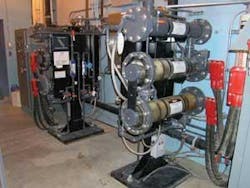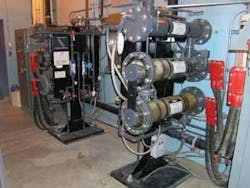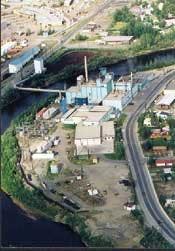by Sam Fleury and Brian Shugrue
Golden Heart Utilities (GHU), a subsidiary of Fairbanks Water & Sewer, treats water and wastewater for more than 55,000 people in the greater Fairbanks, AK, area. The water treatment plant (WTP), which is near downtown and along the banks of the Chena River, is designed to treat 8 million gallons per day (mgd), with an average daily flow of 5 mgd.
Because of its proximity to the river and to downtown Fairbanks, the strict requirements set by the USEPA and the Alaska Department of Environmental Conservation for storing and handling chlorine gas were a constant concern.
Seeking an alternative form of disinfection, GHU contacted Siemens Water Technologies' local representative, TMG Services of Tacoma, WA. TMG conducted a Siemens Life Cycle Cost (LCC) analysis to compare the plant's costs between using chlorine gas, liquid bleach or onsite generation of sodium hypochlorite. The LCC spreadsheet takes local plant data such as labor, power and other costs and combines them with the expected capital costs for all three potential systems.
Once the data were analyzed, GHU determined that an OSEC® onsite generation system from Siemens would be the best choice, providing a payback in capital expenditure of approximately three years. Beyond that, the utility would be saving money over bulk liquid bleach or gas chlorination systems due to the lower operating costs. This is especially important for larger treatment plants, as the greater the quantity of required chlorine in pounds per day (PPD) for a treatment plant, the better the payback over time. This was a deciding factor since the GHU plant in Fairbanks required 500 PPD.
It is important to note that safety concerns are not included in LCC analysis. Since less equipment and fewer safety measures and processes are required for onsite sodium hypochlorite systems, these costs are eliminated, creating an added benefit.
System Safety
Since safety was a driving factor in this change, the overall safety of the onsite generating system was important. The Siemens OSEC product line, which has been on the market for over 30 years, has numerous safety features built into each system to prevent potential explosions. The system incorporates an inter-stage removal of hydrogen gas from each cell, and retains the gas in a confined pipe pathway at a positive 2% grade into the top portion of the solution tank. No open vents or valves are allowed in the lines. Once inside the tank, any entrained gas can safely come out of solution as it is diluted with air and force-vented into the atmosphere via an orifice plate that is linked to the control system.
All electrical components have intrinsically safe barriers to eliminate potential sparking. Additionally, liquid level sensors are included in the top cell to prevent the system from starting if those levels drop for any reason.
Safety is a major factor when installing and operating this technology. Siemens and its local Service Contractors like TMG Services ensure that plant personnel receive thorough training on how to use the equipment during the initial startup. Also, factory authorized experts are available at all times for long-term service and support.
Hypochlorite Generation
Fairbanks installed the OSEC B2-200 model, which consists of two short skids, in June 2004. Each skid has two electrolyzer cells and a capacity of 250 PPD, for a combined total capacity of 500 PPD of equivalent chlorine.
The hypochlorite generating system produces a low-strength sodium hypochlorite solution of 0.8% through the electrolysis of brine, consuming only salt, water and power. In general, it takes 3 lbs of salt, 2 kW-hours of power and 15 gallons of water to produce the equivalent of 1 lb of chlorine gas.
The water is softened, mixed with a brine solution, diluted and then pumped into special electrolyzer cells that contain cathodes and specially coated anodes. When electricity is applied, electrons flow between the cathodes and the anodes. Chloride ions in the water approach the anodes, donate their electrons and form chlorine molecules – the same chlorine molecules found in chlorine gas.
The low concentration level of 0.8% means the solution is non-hazardous, which eliminates the need to develop a Risk Management Plan. The system has a small footprint, making it easy to retrofit practically any plant. The GHU plant installed the system in its old chlorine gas room, which saved time and money.
The operating water temperature greatly affects reaction efficiency. Because of their unique anode coating, OSEC electrolyzer cells have an operating range of 50 to 80°F. However, when plants have incoming water below that range, it must be heated in order to maintain optimal electrolyzer cell performance. This often requires additional electric heaters, which can add more cost (both capital and operational) to a system.
Since Fairbanks has incoming water that averages 45°F, it needs to be heated accordingly. The OSEC system's unique heat exchanger captures the heat naturally generated during the electrolysis process and circulates it back to the inlet water. This heats the water an additional 5 to 7°F without the use of electric heaters, which has resulted in incremental cost savings over time.
Dave Dean, director of administration at Fairbanks Water & Sewer, said he was pleased with the system, which has actually performed beyond what was expected.
"The GHU plant is using less than 3 lbs of salt and less than 2 kW hours per lb equivalent of generated chlorine," Dean said, "and operating costs are subsequently that much less."
About the Authors:
Sam Fleury is WTP plant foreman for Golden Heart Utilities. He can be contacted via e-mail at [email protected]. Brian Shugrue is western regional manager for the Chemical Feed and Disinfection Group for Siemens Water Technologies. Based out of Leavenworth, WA, he can be contacted at [email protected].





